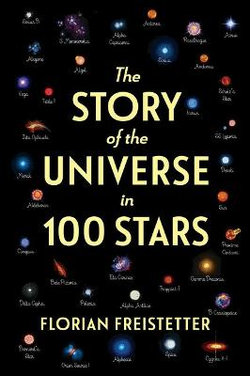
-
Books
-
Education
-
eBooks
-
Audio Books
-
Film & TV
-
Calendars, Diaries & Stationery
-
Giftshop

This title is in stock with our overseas supplier and should arrive at our Sydney warehouse within 2 - 3 weeks of you placing an order.
Once received into our warehouse we will despatch it to you with a Shipping Notification which includes online tracking.
Please check the estimated delivery times below for your region, for after your order is despatched from our warehouse:
This review has been reported as abusive and will be removed from the website temporarily.
This will be reviewed by the Angus & Robertson team and acted on accordingly.
I haven’t studied science since high school but the older I get, the more interesting I find it. I’ve been fascinated by astronomy since I was a kid and you know how much I love fun facts. Whenever I stumble across a book about stars I can’t help myself; I need to find out more.
It never fails to… more floor me whenever I read about how unfathomably ginormous the universe is.
The Milky Way has a “few hundred billion stars” and it’s only one of up to a quadrillion other galaxies in the universe. Each of those consist of “hundreds of billions of stars”.
61 Cygni is 11.4 light years away from Earth. Only twelve stars are closer than it.
I learned the names of the stars that make up the Southern Cross, the first constellation I was able to identify and a symbol that’s tattooed on so many Australians.
Four of the stars that make up the Southern Cross are pretty boring: Acrux, Becrux, Gacrux and Decrux. They were named because the constellation is called Crux and the Bayer system for naming stars is related to how bright they are; the brightest star is Alpha, the second brightest star Beta, third Gamma, fourth Delta, etc., so Alpha Crucis became Acrux. The fifth star, however, actually has a more appropriate name, Ginan, and I love this so much!
“In the stories of the Wardaman people of northern Australia, a ginan is a traditional bag filled with stories and songs and myths about the creation of the world.”
Apologies in advance if I’m ruining your childhood here, but did you know that shooting stars aren’t actually stars?
“They are miniature lumps of rock only a few millimetres wide, and you can find them as space dust everywhere between the planets of our solar system. When Earth meets one of these grains of interplanetary dirt, we see a shooting star. The speck of dust hits the Earth’s atmosphere with a typical speed of between 30 and 70 kilometres per second. During its high-speed flight through the atmosphere, it rips electrons from the shells of the atoms of which the air consists; and when these now shell-less atoms recapture one of the liberated electrons and reattach it, they emit energy in the form of light, which we then perceive as a shooting star.
The whole thing takes place about a hundred kilometres above us and lasts only a few seconds.”
Then there’s the “brightest and most massive” star. This honour goes to R136a1 from the Tarantula Nebula, which is almost 180,000 light years from Earth.
“If R136a1 was where the Sun is, it would exceed the Sun’s brightness by as much as the Sun’s exceeds the Moon’s. R136a1 is a whole 265 times heavier than the Sun, and if it really was the centre of the solar system, the massive increase in gravitational force would shorten Earth’s orbit from 365 days to a mere 21.”
This book reminded me that not only did The X-Files teach me Latin, it also taught me astronomy. So many years later, I came across the term syzygy in this book and not only did I know what it meant, I also remembered the storyline of the episode that introduced me to the word. Thank you, Chris Carter.
Even without a scientific background, I didn’t have any trouble understanding the author’s explanations. I would have loved for the book to have included photos of some of the stars; Google helped me fill this void.
I haven’t read a lot of astronomy books but I found Lisa Harvey-Smith’s The Secret Life of Stars an easier read. If I lost concentration during this book I’d have to reread at least a paragraph to figure out what I’d missed. There was a small amount of repetition, which I can put down to the fact that the author states in the foreword that you can read the chapters in any order.
I’m rounding up from 3.5 stars. less
Thanks for reviewing The Story of the Universe in 100 Stars. We will process your review. Accepted reviews will be posted within 3-7 business days.
Be the first to know, stay up to date with what's trending and get staff picks in your inbox with our newsletter


Public: Allow anyone to view or shop your List
Private: No one can view or shop your List
We have kept your A&R details for your new Angus & Robertson account
We also noticed that you have previously shopped at Bookworld. Would you like us to keep your Bookworld order history?
We also noticed that you have an account on Bookworld. Would you like us to keep your Bookworld details, including delivery addresses, order history and citizenship information?
Share This Book